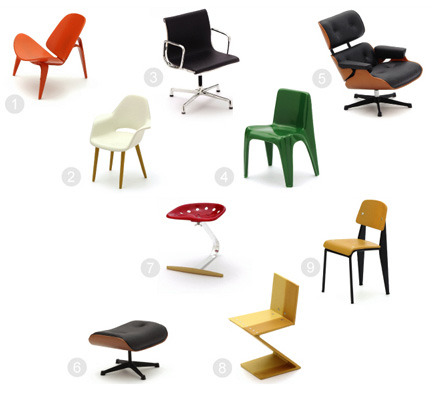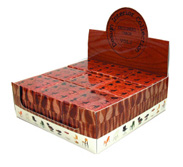
This collection includes miniature reproductions of some of the most famous pieces of furniture of the 20th century, 1:12 scale.
1. CH07, 1963
Designer: Hans Wegner
This is one of Wegner’s most iconic pieces. The three-legged chair achieves a floating lightness due to its wing-like lines and the arching curves and tapered shapes of its laminated legs. Sometimes referred to as “The Smiling Chair”, CH07 is renowned for both its lasting good looks and its generous comfort. CH07 was originally designed in 1963, a few limited series were produced, but the project soon came to a stand still. The 90s brought a growing interest in chairs of more individual designs and Carl Hansen & Son relaunched the CH07 in 1997. In 1999 one of these chairs produced using the 1960s technology was sold at Christie’s in London for 104 Danish krones (more than 150 thousand US dollars).
In 2008 Carles Hansen and Son celebrated their 100 anniversary. For this occasion they launched a limited edition of the chaircrafted from exclusive zebrano veneer (a first for the CH07) and upholstered in Elegance Special Brown leather, a supple aniline specially chosen for its rich colour and soft texture. Only 250 pieces of this special edition will be made, ever. Each chair carries a sterling silver plate with its special edition number (the plate is placed underneath the chair). This chair was presented at IMM Cologne 2009 expo in Cologne, Germany.
2. Organic Chair, 1940
Designers: Charles Eames, Iiro Saarinen
This comfortable small reading chair was made in 1940 as a contribution to the New York MoMA’s Organic Design in Home Furnishings competition. Formally speaking it was ahead of its time, but owing to the lack of manufacturing techniques, never went into series production.
It was mass-produced for the first time in 2004. And 2007 saw a new version of the design, Organic Highback with elongated backrest and wider armrests.
This chair can be found in the Vitra Design Museum, Germany.
3. Aluminum Chair, 1958
Designers: Charles and Ray Eames
You know it at first glance—it’s an Eames design. Timeless, sophisticated, refined. The lithe Aluminum Group chair bears the distinctive stamp of Charles and Ray Eames, the most famous design couple in the world. This graceful silhouette sits equally well in retro interiors, elegant lobbies, or hip young offices. Add executive, management, side, and lounge models, and there’s everything you need for a statement of enduring design excellence.
Aluminum Group chairs began as a challenge among legendary designers. Eero Saarinen and Alexander Girard were designing the Columbus, Indiana, home of J. Irwin Miller, founder of Cummins Engines. They wanted a high-quality seating product for outdoor use and asked Charles and Ray Eames to develop one.
The chairs in the Aluminium Group are the most famous creations by Charles and Ray Eames. Designed in 1958 they rate amongst the great achievements in the design history of the 20th century.
An important characteristic of the Aluminium Chair is the intelligent combination of materials. It has a clear, transparent form and its construction is clearly visible. Aluminium sections lend the chair both stability and lightness. The material is fixed into the side sections, yet fitted loosely so that it follows the line of the body and is comfortable without requiring extensive upholstery. This material is not a cover but an integral part of the design.
4. BA 1171,
Designer: Helmut Batzner
Helmut Batzner designed the first “sculptural” plastic chair made out of one piece. Plastic became widely used in furniture production in the early 1940s partly thanks to Iiro Saarinen’s and Charles and Ray Eames’ works. The idea of creating a one-piece plastic chair was incredibly popular and many European designers strived to realize it.
Batzner created BA 1171 in
The chair was excellent for mass production.suitable for mass production. It was compression moulded using the prepeg-process and a ten ton double shell heated press. The production cycle lasted five minutes and only a small amount of finishing was required. Launched into mass production in 1966, it is available five colors: red, white, yellow, green and black.
Life-size BA 1171 chair war produced by Wilgelm Bofinger in 1966–1984.
5, 6. Lounge chair and ottoman, 1956
Designers: Charles and Ray Eames
Most of the work of Charles and Ray Eames’ studio was devoted to developing mass-manufactured furniture at affordable prices, but the Lounge Chair was an exception. The Eames had first tried to design a contemporary US equivalent of a traditional English club chair in the early 1940s eventually producing the 1945 Lounge Chair Wood.
The classic version of the Lounge chair with black leather upholstery, dark jacaranda wood shell and black painted aluminum base, is considered iconic.
Ten years later they decided to design a more opulent version which Charles envisaged as having the “warm receptive look of a well-used first baseman’s mitt”. The result combines industrial production with hand craftsmanship in leather upholstery and a moulded plywood shell with a rosewood veneer that enables the chair to move with the sitter.
Salone Internazionale del Mobile 2010 in Milano saw a larger version of the chair. The reason it had to be redesigned is that over the last 50 years people have simply grown taller and the chair no longer fit.
The Eames supervised the redesign. The new larger version has a deeper seat, adjustable armrests and an elongated backrest. The ottoman remained the same size and shape.
7. Mezzandro,
Designers: Achille and Pier Giacomo Kastiglioni
Inspired by the ready-made sculpture of the early 20th century artist Marcel Duchamp, Achille Castiglioni (1918-2002) and his brother Pier Giacomo often made furniture from found industrial objects, such as the racing bicycle saddle of the Sella stool and the tractor seat of this Mezzadro chair.
The choice of the tractor seat, a reference to the modernisation of Italian agriculture, evoked the brothers’ passion for industry and Italy’s rustic traditions. Although reduced to essential elements, these seats evoke wit and playfulness. Both were considered too radical to be manufactrued in the 1950s and it was not until 1983 that the brothers persuaded Zanotta to reissue their original designs.
The chair is part of the the Vitra Design Museum collection, Germany.
8. Zig-Zag,
Designer: Gerrit Thomas Rietveld
The son of a Utrecht cabinetmaker, Gerrit Thomas Rietveld worked in his father’s workshop as an apprentice craftsman from the age of eleven. In his early twenties Rietveld opened his own cabinetmaking workshop while pursuing his passion for architecture by enrolling on an architectural drawing course. Rietveld’s early work with wood reinforced his later role as a radical designer, architect and member of the avant garde De Stijl movement.
It gave him the technical expertise to put some of De Stijl’s principles into practice, notably by realising its zest for oblique diagonal lines in this cantilevered Zig-Zag chair.
9. Standard, 1930
Designer: Jean Prouvé
Chairs take the most strain on their back legs, where they bear the weight of their user's upper body. Prouvé took this into account very succinctly in Standard Chair.
Tubular steel piping is enough for the front legs that take relatively little strain, whereas the back legs are made of voluminous hollow sections and pass the strain on to the floor.
Japan
Weight: 900 g
Produced by Reac Japan
Materials: plastic, vinyl, rubber
Package dimensions: 300×300×100 mm (11.8″×11.8″×3.9″)
Not recommended for children under 7.

Shipment and payment
We accept Visa and Mastercard as methods of payment. Purchases delivered by courier in Moscow, Russia can be paid for with cash.
We can ship almost anywhere in the world. Shipping costs and available delivery methods (courier, mail, or pick up) will be shown during checkout. Delivery time and cost will vary based on the chosen service, order weight and distance to the destination.
If you are not satisfied with your purchase for any reason, we'll take it back, no questions asked.
See all reviews
See all reviews